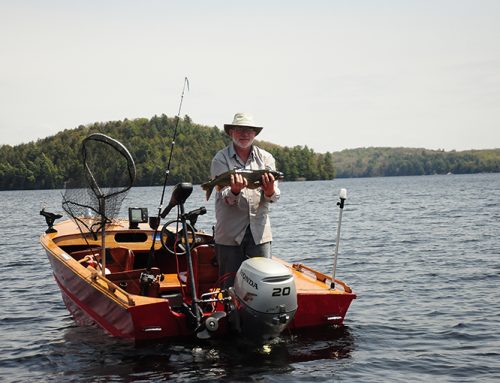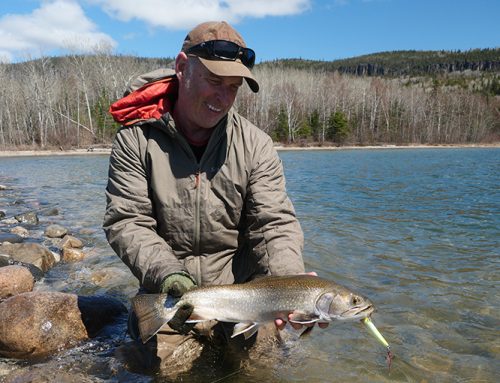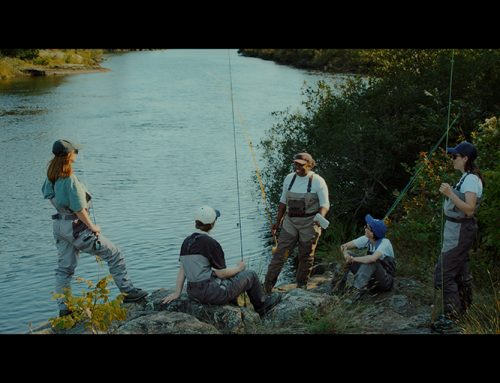
I consider myself fortunate. As a child, my parents and their friends often took me fishing. Now, things have come full circle. I’ve got an outdoorsy preschooler who’s showing interest in all things fishy and nephews who have been bit by the angling bug. It’s my turn to pay it forward.
I’m no expert on child development or recreation, but I’ve learned a lot about how to make sure new anglers have a good time. The following are some suggestions to ensure your family fishing time is fun for everyone. The focus is on children, but many of these tips apply to older beginners as well.

Pro tip: don’t guarantee fish
Checking expectations
Setting realistic expectations for both you and your kids is a good first step. In your dual role as parent (or uncle, or aunt, or grandparent) and angling guide, it’s important to be realistic, keeping in mind what children might and might not be able to do.
My 2 1⁄2-year-old daughter can handle about a 60-minute car ride before getting antsy. This is my distance limit and you can bet there’s some run-around time at the destination before we start fishing. Our fishing time is also short, sometimes just a couple of hours. A full day on the water is a few years down the road, and that’s cool by my daughter and me.
Fishing should be simplified as much as possible for beginners. You can catch a lot of fish with live bait or smelly soft baits dangled beneath a float. Keeping strategies basic makes it easier to focus attention on your family.
Here’s another reality check. Don’t expect to do much, if any, fishing yourself when shepherding young anglers. Unless you hire a guide, you’re fulfilling this role. Your job is to keep everyone safe, put beginners on fish, educate, and entertain. Achieve this and your end-of-day gratuity might be a hug, a kiss, or a request to go fishing again — and that’s priceless.
Talk with children, too, about fishing leading up to the outing. Explain where you’ll go, how fishing works, the activities you’ll do, and what might or might not happen. Kids like to know what’s going on.

OOD walleye columnist Tim Allard is an avid angler and father.
Hire a guide
Hiring a guide can provide another unique experience for your family. A quality guide is going to know where the fish are located. Hiring a guide is also advantageous on holiday trips, as it saves packing fishing gear or towing a boat.
A guide will also manage many fishing tasks, such as boat control and rebaiting hooks, freeing you to focus on quality time with the family, catch some fish, and maybe even sneak in some R&R when no one’s looking.
Before booking, ask a guide about their approach to family fishing and check their references. An expectations chat goes a long way to ensuring a successful trip. Book early. Good guides are in high demand.
Share your family memories and submit photos to our Memory Bank.
Fish in fair weather
Generally, pleasant weather fosters enjoyable fishing, but you don’t necessarily need travel-brochure conditions to have a good time. Low winds and light rain are doable with decent rain gear, but stay at home in nasty weather. Shore fishing a sheltered bank during high winds is a reliable Plan B.
Boat traffic increases on holidays and during warm weather. Plan to be on and off the water early to avoid bobbing among boat wakes. If conditions turn bad, retreat to a sheltered area away from the main channel, or call it a day.
Another bonus of early morning outings is that fish tend to be active. Plus, the sun’s intensity won’t have peaked, and sun exposure should always be on your radar.

Kids derbies Often free, kids fishing derbies are another great activity, and there are lots of them hosted around the province.
Enjoy the entire experience
Catching fish is awesome, but having a positive experience on the water is what family fishing is really about. The outdoors is your playground and classroom, so enjoy it. Talk about the birds, animals, and insects that live around water.
The same goes for exploring in the boat. For 15 minutes during a one-hour fish, my daughter operated the trolling motor pedal, under my watchful eye, of course. Do you have any idea how cool it is for a toddler to steer a boat, and do it with their foot? Answer: very. Dibs, dear readers, on the idea of a children’s book and animated movie entitled, Trevor the Trolling Motor.

Mix it up
Monitor your young anglers’ interest and energy level. Take breaks from fishing and mix up the activities. A boat ride is a great way to lift everyone’s spirits. A swim is also refreshing in hot weather, but be aware that getting in and out of a boat in open water can be tricky.
Heading back to the dock so folks can use the washroom, have a picnic, or run around on shore can also be a good move.
Food is your friend
I’ve seen grown men become giddy over homemade butter tarts or fresh strawberries shared from my lunch box. Youngsters are no different and their high metabolisms need steady fuel. Pack a well-balanced cooler with drinks, sandwiches, fruit, veggies, and a few sweet treats. Keep kids satisfied and hydrated. Otherwise, someone’s going to end up wearing their cranky pants, and I’m not just talking kids here.

Score from shore
Angling from shore can be a hoot as panfish, bass, catfish, and small pike are often catchable from the bank. Another perk of shore fishing is that children aren’t constrained and can explore when they need a change of activity. Park washrooms and the occasional chip stand are definite bonuses.
Some of my most relaxing outings have been carping on the St. Lawrence with my dad, brother, wife, and friends. Chum the area, cast out a baited hair-rig, then sit back in a lawn chair and catch some rays while munching on snacks. “Carp Club Med” is what my dad calls it.
Tackle tips
The right equipment makes fishing a more pleasant experience. Here are a few quick tackle considerations. There are lots of junior rod-and-reel combos available, and you tend to get what you pay for.
are lots of junior rod-and-reel combos available, and you tend to get what you pay for.
An icefishing rod is also a great option for little ones. They are lightweight, have small handles, and are kid-sized. Regardless of rod style, it’s a good idea to have a backup combo.
For safety’s sake, use single hooks instead of trebles and consider going barbless. It speeds up catch and release, and heaven forbid, if someone gets stuck with a hook, it can be removed right away.
When it comes to soaking bait for catfish or introducing rookies to stickbaits for bass, circle hooks are also a winner in my boat.
Under steady pressure, a circle hook positions itself in the corner of a fish’s mouth, bypassing the need to set a hook, which beginners sometimes forget to do.
Two other tackle must-haves are floats and swivels. Floats help focus kid’s attention, and they signal a bite. Swivels reduce line twist, which can lead to line tangles.
Willing biters
Target plentiful species that are eager biters when introducing your family to fishing. Where I fish in southeastern Ontario, panfish, catfish, and bass rank high on the list. One of the most fun outings I’ve had in a long time was with my then nine-year-old nephew Jared, my brother in-law Tim, and my wife Sue on Charleston Lake.
A quick scan of a lake map revealed a six- to 10-foot flat just a short boat ride from the campsite. For 45 minutes we had steady action from bluegills and pumpkinseeds. Loaning folks extra sets of polarizing glasses lets them see sunfish swimming among the weeds. “It was just like an aquarium,” Jared said later around the campfire.
Let kids fish
One of the many enjoyable things about fishing is the freedom to fish as you choose. Share this joy with children. Encourage them and help when asked, but let them do their own thing. If they want to change a lure or cast in a different direction, let them.
When their line tangles (and it will), involve them in problem solving. Minus the parenting slant, this same approach applies to youth and adult beginners.

Castin’ ain’t easy
Fishing requires many learned skills. Try to engage kids (or adults) in practising casting in the backyard or at a park. Set them up with a hookless weight and a target, such as a plastic container or a hula hoop. Make a game of it.
Setting the hook is another acquired skill. It might be best to do this for your young anglers a few times, or employ circle hooks, as noted earlier. Remember, though, that children learn by doing, so give them some gentle positive reinforcement and guidance, and let them try.
Beyond the basics
As a child’s fishing skills develop they might take an interest in different tactics, such as using lures, which opens up a whole new set of experiences. You can bet kids will be curious about shapes, colours, and when to use which lures to catch specific fish. Below are some basic multi-species tactics to consider when branching out beyond live-bait rigs:
- A wacky-rigged stickbait is a great option for fishing shorelines, flats, and along outside weed edges.
- Small spinnerbaits, inline spinners, and shallow-running minnowbaits are great for anglers who like to reel continuously.
- A drop-shot rig is another winner. Teach them how to feel when the sinker is on bottom and let the finesse plastic do the work as you manoeuvre the boat around the hot fishing area.

Drifting a drop-shot rig was the hot tactic for smallmouth recently with my young nephew, Ryan, on the St. Lawrence. He quickly learned that when the rod vibrations changed from squishy sand to hard “ticks” on rock, odds were good a smallie was going to bite. Then, when his rod loaded up, he set the hook like a pro and it was game on. That was a great day on the water.
End on a high
Consider your exit strategy for the day. A successful guide once told me he takes clients to a reliable spot so they can catch a few more fish before he drops them off at the dock. Quality time with family is a precious thing. Introducing children and other beginners, from youths to adults, to fishing can be rewarding.
Expect a few hiccups along the way and realize that things might not go as planned. Make having fun the number one priority, consider catching fish a bonus, and remember to be positive and patient. This should come easily — you’re an angler after all.
Safety and comfort
Here are some common sense tips. Wear PFDs, regularly apply and reapply sunscreen, and carry first aid and medical kits in the boat or vehicle if shore fishing. As with any sharp, pointy thing, lures and hooks shouldn’t be handled by small children.
Keep scissors and other angling tools tucked away, too. Lures whizzing by at head level are dangerous. Close-quarter casting demands diligence. Teach and use side-arm casts, along with shoulder checks to see if anyone is behind you. And tell others when you’re walking behind them to prevent casting accidents.
Links of interest
-Camping at a provincial park? Check if a Learn to Fish session is happening onsite: www.ontarioparks.com/learntocamp/learntofish.
-Ontario government guide: www.ontario.ca/document/learn-to-fish-guide
-Canada’s National Fishing Week: www.catchfishing.com.
-Ontario Family Fishing Week: www.ontariofamilyfishing.com.
This article originally appeared in the July 2015 issue of Ontario OUT of DOORS magazine.






Leave A Comment